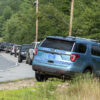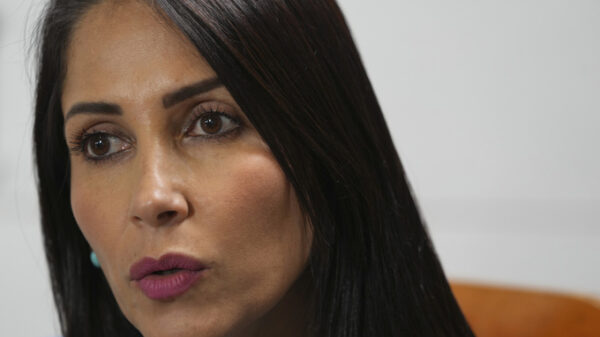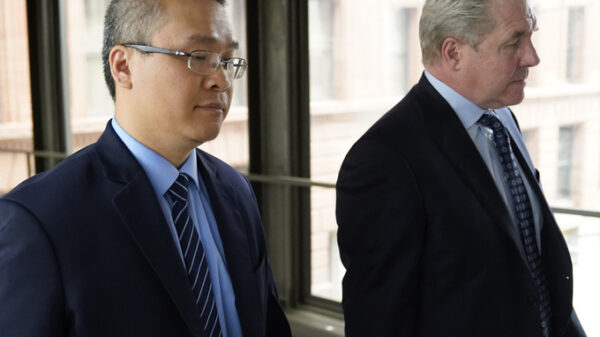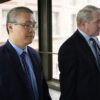Kyle Rittenhouse looks back before going on a break during his trail at the Kenosha County Courthouse in Kenosha, Wis., on Monday, Nov. 15, 2021. (Sean Krajacic/The Kenosha News via AP, Pool)
KENOSHA, Wis. (AP) — Jurors weighing charges against Kyle Rittenhouse were to return Wednesday for a second day of deliberations in his murder trial, after they failed to reach a swift verdict on whether he was the instigator in a night of bloodshed in Kenosha or a concerned citizen who came under attack while trying to protect property.
The jury of 12 deliberated for a full day Tuesday without reaching a decision. Several appeared tired as they walked into the courtroom Tuesday evening and indicated with a show of hands that they were ready to go home.
The case went to the anonymous jury after Judge Bruce Schroeder, in an unusual move, allowed Rittenhouse himself to play a minor role in selecting the final panel of 12 who would decide his fate. Rittenhouse reached into a raffle drum and drew numbered slips that determined which of the 18 jurors who sat through the case would deliberate and which ones would be dismissed as alternates.
KENOSHA, Wis. (AP) — Jurors weighing charges against Kyle Rittenhouse were to return Wednesday for a second day of deliberations in his murder trial, after they failed to reach a swift verdict on whether he was the instigator in a night of bloodshed in Kenosha or a concerned citizen who came under attack while trying to protect property.
The jury of 12 deliberated for a full day Tuesday without reaching a decision. Several appeared tired as they walked into the courtroom Tuesday evening and indicated with a show of hands that they were ready to go home.
The case went to the anonymous jury after Judge Bruce Schroeder, in an unusual move, allowed Rittenhouse himself to play a minor role in selecting the final panel of 12 who would decide his fate. Rittenhouse reached into a raffle drum and drew numbered slips that determined which of the 18 jurors who sat through the case would deliberate and which ones would be dismissed as alternates.
As the jury deliberated, dozens of protesters — some for Rittenhouse, some against — stood outside the courthouse. Some talked quietly with those on the other side, while others shouted insults. One woman could be heard repeatedly calling some Rittenhouse supporters “white supremacists.”
Wisconsin Gov. Tony Evers, who faced criticism over his response to the Kenosha protests in 2020, urged calm as the jury deliberated. He announced last week that 500 members of the National Guard would stand ready for duty in Kenosha if needed.
“Regardless of the outcome in this case, I urge peace in Kenosha and across our state,” Evers tweeted. He added: “I ask all those who choose to assemble and exercise their First Amendment rights in every community to do so safely and peacefully.”
The large protests that some had anticipated did not materialize during the trial’s testimony phase. On most days, only a few demonstrators gathered on the courthouse steps, and the high fence that protected the building during last year’s unrest is gone.
Rittenhouse was 17 when he went to Kenosha from his home in Antioch, Illinois, in what he said was an effort to protect property from rioters in the days after a Black man, Jacob Blake, was shot by a white Kenosha police officer.
In a fast-moving series of clashes in the streets, Rittenhouse shot and killed Joseph Rosenbaum, 36, and Anthony Huber, 26, and wounded Gaige Grosskreutz, now 28.
During closing arguments Monday, prosecutor Thomas Binger said that Rittenhouse was a “wannabe soldier” who set the deadly chain of events in motion by bringing a rifle to a protest and pointing it at protesters just before he was chased.
But Rittenhouse lawyer Mark Richards countered that Rittenhouse was ambushed by a “crazy person” — Rosenbaum.
Rittenhouse testified that Rosenbaum chased him down and made a grab for his rifle, causing him to fear the weapon was going to be used against him. His account of Rosenbaum’s behavior was largely corroborated by video and some of the prosecution’s own witnesses.
As for Huber, he was gunned down after he was seen on video hitting Rittenhouse with a skateboard. And Grosskreutz admitted he had his own gun pointed at Rittenhouse when he was shot.
In his instructions to the jury, Schroeder said that to accept Rittenhouse’s claim of self-defense, the jurors must find that he believed there was an unlawful threat to him and that the amount of force he used was reasonable and necessary.
Forliti reported from Minneapolis; Webber from Fenton, Michigan. Associated Press writer Scott Bauer contributed from Madison, Wisconsin.
Copyright 2021 Associated Press. All rights reserved.





























